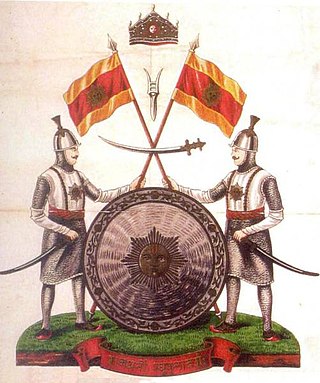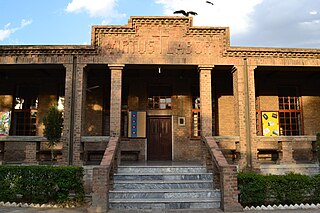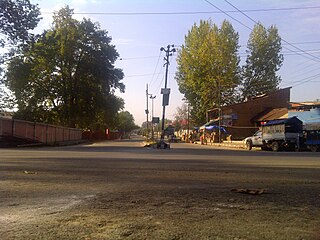
Srinagar is a city in Indian-administered Jammu and Kashmir in the disputed Kashmir region. It is the largest city and summer capital of Jammu and Kashmir, which is an Indian-administered union territory. It lies in the Kashmir Valley along the banks of the Jhelum River, and the shores of Dal Lake and Anchar Lakes, between the Hari Parbat and Shankaracharya hills. The city is known for its natural environment, various gardens, waterfronts and houseboats. It is also known for traditional Kashmiri handicrafts like the Kashmir shawl, papier-mâché, wood carving, carpet weaving, and jewel making, as well as for dried fruits. It is the second-largest metropolitan area in the Himalayas.

Sir Hari Singh was the last ruling Maharaja of the princely state of Jammu and Kashmir of the Dogra dynasty.

Uri is a town and a tehsil in the Baramulla district, in the Indian union territory of Jammu and Kashmir. Uri is located on the left bank of the Jhelum River, about 10 kilometres (6.2 mi) east of the Line of Control with Pakistan.

Baramulla, also known as Varmul in Kashmiri, is a City and municipality of the Baramulla district of the Indian-administered Jammu and Kashmir in the disputed Kashmir region. It is also the administrative headquarters of the Baramulla district, located on the banks of the River Jhelum downstream from Srinagar, the summer capital of Jammu and Kashmir. The town was earlier known as gateway of Kashmir, serving as the major distribution centre for goods arriving in Kashmir valley through the Jhelum valley cart road. It is located within the Kashmir Valley on the foothills of the Pir Panjal Range.

Karan Singh is an Indian politician and philosopher. He is the titular Maharaja of the princely state of Jammu and Kashmir. From 1952 to 1965 he was the Sadr-i-Riyasat (President) of the state of Jammu and Kashmir. He is the chairperson trustee of the Dharmarth Trust of Jammu and Kashmir which maintains 175 temples in north India and works in other areas such as historical preservation.

Pratap Singh was the Maharaja of Jammu and Kashmir, and head of the Jamwal Rajput clan of the ruling Dogra dynasty.

The Dogra dynasty of Dogra Rajputs from the Shivalik hills created Jammu and Kashmir through the treaties with the East India Company following the First Anglo-Sikh war. Events led the Sikh Empire to recognise Jammu as a vassal state in 1820, and later the British added Kashmir to Jammu with the Treaty of Amritsar in 1846. The founder of the dynasty, Gulab Singh, was an influential noble in the court of the Sikh emperor Maharaja Ranjit Singh, while his brother Dhian Singh served as the prime minister of the Sikh Empire. Appointed by Ranjit Singh as the hereditary Raja of the Jammu principality, Gulab Singh established his supremacy over all the hill states surrounding the Kashmir Valley. After the First Anglo-Sikh War in 1846, under the terms of the Treaty of Lahore, 1846, the British East India Company acquired Kashmir from the Sikh Empire and transferred it to Gulab Singh, recognising him as an independent Maharaja. Thus, Jammu and Kashmir was established as one of the largest princely states in India, receiving a 21-gun salute for its Maharaja in 1921. It was ruled by Gulab Singh and his descendants until 1947.

Poonch Jagir, also called Poonch district, was former semi-autonomous region in the princely state of Jammu and Kashmir. The territory was divided between India and Pakistan in 1947, represented by the present-day Poonch Division of Azad Kashmir and Poonch District of Jammu and Kashmir.

St. Ann's Presentation Convent High School, Rawalpindi, is a private Catholic missionary school located in Lalkurti area of Rawalpindi Cantonment, Pakistan. In spite of its name, the school caters for students seeking an elementary and high school education.
Presentation High School may refer to:

Presentation Convent High School, Jhelum, is a school located in Jhelum Cantonment. It was founded by the Presentation Sisters and is regulated by the Catholic Board of Education under the Roman Catholic Archdiocese of Lahore.

The Sher Garhi Palace is a historic royal residence in Srinagar, Jammu and Kashmir, India. Situated south of the Old City of Srinagar, along the banks of the Jhelum River, its name,"Sher Garhi," translates to "Fort of the Lion,"highlighting its role as a prominent seat of power. Initially constructed in 1772 by Afghan governor Jawansher Khan, it served as the residence of Afghan rulers before becoming home to the Dogra Maharajas of Jammu and Kashmir.

In September 2014, the Kashmir region suffered disastrous floods across many of its districts caused by torrential rainfall. The Indian state of Jammu and Kashmir, as well as the Pakistani territories of Azad Kashmir, Gilgit-Baltistan and the province of Punjab were affected by these floods. By 24 September 2014, nearly 277 people in India and about 280 people in Pakistan had died due to the floods.

Rajbagh is the notified area in the municipal committee of Srinagar, in the Indian union territory of Jammu and Kashmir. It comes under the Lal chowk Constituency. Rajbagh is a posh locality in the civil line area of Srinagar. The postal code of Rajbagh is 190008. Rajbagh is considered one of the many best residential places in Srinagar. There are many hotels, restaurants and schools in this locality. Rajbagh area was heavily damaged by the 2014 Kashmir floods, it was one of the worst affected areas due to flood.
Karan Nagar is the notified area and the town in the city of Srinagar in the Indian administered union territory of Jammu and Kashmir. A portion of Karan Nagar in the name of Deewan Bagh was the first declared civil colony in 1942 by the former princely state government of Jammu and Kashmir. It is a posh locality of Srinagar city. The famous SMHS hospital and Government Medical College is located here. It is located about 2 km (1.2 mi) from the commercial center of Kashmir, Lal Chowk.
Sri Pratap Higher Secondary is an all-boys school located at M.A. Road, Srinagar. It is one of the oldest school in Srinagar, locally known as S.P school. It was established in 1874 by the King of Jammu and Kashmir himself, Maharaja Ranbir Singh and is named after his successor Sri Pratap Singh. The school has risen from ranks starting as a middIe school then a high school after that becoming a higher secondary school and being elevated to the status of Model School by the state government. It is a selective school that offers admission on the basis of merit. The school has produced a line of distinguished alumni.

Brigadier Rajinder Singh Jamwal, MVC, also remembered as the Saviour of Kashmir, was an officer in the Jammu and Kashmir State Forces. He briefly served as the Chief of Staff of State Forces and died fighting during the First Kashmir War. Rajinder Singh and his small contingent of about 100 men successfully delayed the advance of a 6000 strong force of Pakistani tribal raiders near Uri for several days, during which the Maharaja of Kashmir acceded to India and the Indian forces air-lifted for the defence of Kashmir.

In spring 1947, an uprising against the Maharaja Hari Singh of Jammu and Kashmir broke out in the Poonch jagir, an area bordering the Rawalpindi district of West Punjab and the Hazara district of the North-West Frontier Province in the future Pakistan. It was driven by grievances such as high taxes, the Maharaja's neglect of World War veterans, and above all, Muslim nationalism with a desire to join Pakistan. The leader of the rebellion, Sardar Ibrahim Khan, escaped to Lahore by the end of August 1947 and persuaded the Pakistani authorities to back the rebellion. In addition to the backing, Prime Minister Liaquat Ali Khan authorised an invasion of the state, by the ex-Indian National Army personnel in the south and a force led by Major Khurshid Anwar in the north. These invasions eventually led to the First Kashmir War fought between India and Pakistan, and the formation of Azad Kashmir provisional government. The Poonch jagir has since been divided across Azad Kashmir, administered by Pakistan and the state of Jammu and Kashmir, administered by India.
Chitrangada Singh is an Indian businesswoman and a descendant of the former ruling family of a major princely state during the British Raj in India.
Dharmarth Trust in Jammu and Kashmir was founded by Maharaja Gulab Singh in 1846 as an endowment for religious charity, and to manage and support Hinduism. In 1884, and under Maharaja Ranbir Singh, the Ain-i-Dharmath or 'The Regulations for the Dharmarth Trust' were formulated and a government department for religious affairs was created. The trust helped the Dogra dynasty to consolidate and validate its control over its territory and over the functioning of Hinduism in the region.















